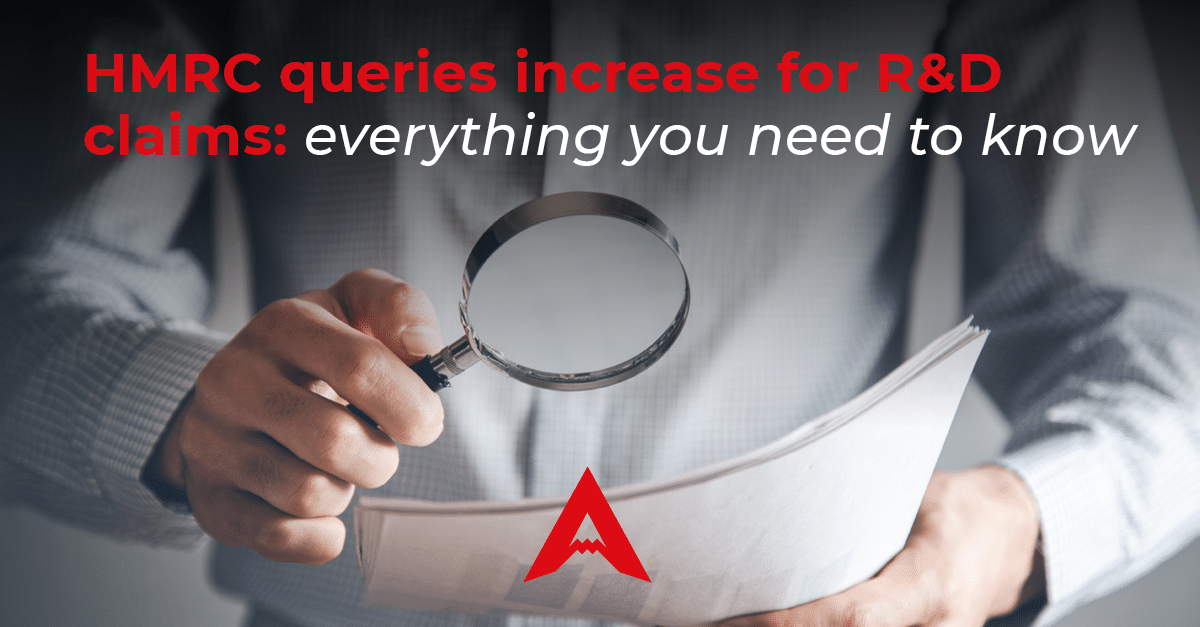
HMRC queries increase for R&D claims: everything you need to know
As part of HMRC’s campaign to clamp down on erroneous and fraudulent R&D claims, they have launched the Mandatory Random Enquiry Program (MREP). [1]
The MREP is part of a wider HMRC risk assessment strategy that aims to prevent abuses of the R&D schemes. [2]
In this blog, we’ll take you through everything you need to know about the increase in HMRC’s queries as part of the MREP, the implications on your R&D claim, and how we can support you.
Why has HMRC introduced MREP?
As abuse of the R&D schemes has grown over the last few years, so too has scrutiny over HMRC’s ability to manage the schemes effectively. [3]
In response, HMRC are taking action, with their stated aims of better understanding the level of non-compliance and ensuring the Government’s money is awarded effectively to support legitimate claims. [2]
The MREP programme aims to investigate non-compliance levels by selecting a random sample of claims and examining these in greater detail. [1]
HMRC has said:
“Random enquiry programmes allow HMRC to estimate the extent of under-declaration of liabilities arising from the submission of incorrect returns. Each return selected is subject to a full enquiry involving a complete examination of books and records.[4]
To support the new programme, HMRC’s R&D compliance team has grown significantly, allowing them to investigate a larger proportion of claims. [5]
What effect is this having?
The increased focus on claims means the R&D tax relief industry – including us – is seeing an increase in the number of applications being queried, regardless of their eligibility and strength.
Therefore, it’s important to be absolutely confident on the eligibility of the claim and ensure this is well substantiated by a strong narrative. Failure to substantiate claims can result in HMRC requiring adjustments or may even result in penalties. [6]
How does it work?
The enquiries are random, and we can’t predict which applications will be flagged by HMRC.
It’s important to know that if your application is selected, it doesn’t necessarily mean there’s a problem with it.
Once an application is selected by the MREP, HMRC then need to launch an enquiry into that application. [7]
Some businesses will be more likely to see enquiries coming their way. The following characteristics make a claim more likely to be flagged in the risk assessment process:
- Change of circumstances – for example, if your R&D tax claim is significantly larger than previous years
- Your business is within a sector that typically doesn’t involve a large amount of R&D
- Goup companies contracting internally, sharing R&D activities, or those with international stakeholders or investors
- If your business receives grants as these circumstances often result in a greater number of errors in R&D claims [7]
What happens if your claim is selected for an enquiry?
If selected, HMRC is likely to request additional information to verify the eligibility of an application in greater detail. [8]
HMRC will send a letter to notify you that they are opening an enquiry or a compliance check on the application. In most cases, the letter will include the additional information that HMRC is looking to receive and the deadline for it.
It’s important to acknowledge that postage could often reduce the time available to prepare the response, so it’s advisable to ask for more time to avoid the risk of missing the deadline.
At this point, the claimant will need to collect all the additional information requested and supporting documentation and combine this into a formal response that will need to be submitted to HMRC. [8]
Once the response is received, the case worker will examine the additional information and answers provided and make a decision on whether to close the enquiry or investigate the case further. [8]
Taking care of R&D claims in-house? Here’s how to prepare for an enquiry
While there’s no guaranteed way to avoid your claim being subjected to an enquiry, there are ways to ensure your business is ready for enquiries in future claim periods:
- Keep on top of tracking and recording R&D expenditure and activities throughout the year.
- Keep a detailed record of expenditure, the activities they relate to, and how you’ve calculated the claim amount (if you’re doing this in-house).
- Provide sufficient supporting information with your claim by ensuring your technical report includes a strong narrative able to support your costs while addressing HMRC’s guidance.
- Take your time when recording calculations and figures for your claims to avoid errors.
- Make sure you understand what you’re claiming for and why.
If you need help with any of the above, get in touch and we can talk you through it.
How can Apogee help?
If you work with Apogee for your R&D relief and receive an enquiry from HMRC, the first step is to inform the team and send us a copy of the letter. This could also be received at our address, in which case we will inform you right away.
We can act on your behalf and will communicate with HMRC to bring the enquiry to a positive conclusion.
One of our experienced R&D experts will handle the process, supporting you in the identification of all the relevant information requested by HMRC (this usually just involves referring back to the relevant points in the technical report we have already compiled for you).
We will also articulate a comprehensive response that addresses all of HMRC’s concerns, supporting the answers with references to relevant sections of the guidance.
Once the response is completed, you will receive a draft for your approval and, providing you’re happy with it, the team will send it to HMRC on your behalf.
How can you help HMRC process your claim faster?
In a message to the Chartered Institute of Taxation, HMRC have provided the following guidance:
- Please ensure you have completed all entries on the R&D section of your Corporation Tax return (CT600 form)
- It is now mandatory to submit additional information with your claim, such as the R&D report, to will help HMRC process your claim quicker
- Review the latest guidance on completing your CT600 form on GOV.UK
- If you submit a claim that is incorrect, inflated or fraudulent then you may be liable to a penalty. Read HMRC: standards for agents. [9]
How to defend your MREP query for R&D tax relief
So, you’ve submitted your application for R&D tax relief, and it’s been selected by HMRC’s Mandatory Random Enquiry Program (MREP).
Your chosen agent has responded to the query and provided the additional information requested, but it’s still not been resolved.
What do you do next?
If HMRC takes an opposing and entrenched position towards your claim, but you still believe in the eligibility of the work, where can you go from there?
Option 1: Ask for a Statutory Review
If you’re unhappy with the decision given by HMRC, you usually have 30 days to file an appeal. [10]
HMRC will then usually give your case to another tax officer who will conduct a second review of your claim and the initial decision made.
You should receive the findings of your review within 45 days, which can result in the reversal of the original decision, an adjustment to the decision made, or an amendment.
If the decision from the review is unsatisfactory, you can then take the matter further. [10]
From there, it’s crucial that you get professional advice and support to help you navigate the next stages.
Option 2: Ask for Alternative Dispute Resolution (ADR)
An Alternative Dispute Resolution (ADR) consists of a mediator trained by HMRC working with you and the officer dealing with your case. [11]
Their role is to help both parties find a way to resolve your dispute.
When you submit an application for ADR, HMRC will review it and get back to you within 30 days to let you know if this is the right route for your case. [11]
HMRC states that ADR is particularly useful in cases where:
- Communications have broken down between you and HMRC
- There are disputes about the facts
- A dispute appears to be the result of a misunderstanding
- You want to know why HMRC has not agreed evidence you have given them, and why they want to use other evidence
- You’re not clear what information HMRC has used, and you think they may have made wrong assumptions
- You want HMRC to explain why they need more information from you.” [11]
If your application is rejected, or your case can’t be resolved through the ADR process, your mediator will give you advice on what you can do next.
Option 3: Appeal to the Tax Tribunal.
The First-tier Tribunal for tax is an independent body, operating outside of the Government and HMRC. [12]
Use of the Tax Tribunal tends to be a last resort and can therefore only be used after an unsatisfactory review or ADR experience. You typically have 30 days to appeal to the Tax Tribunal from the date of your ADR or review decision. [12]
How does the process work?
You’ll get a letter from the tribunal to tell you what will happen next. You may be asked to provide supporting documents for your case, and it’s possible that you’ll be invited to attend a hearing (if not you can ask for one).
You’ll need to provide all documents relevant to your appeal, along with the notice of appeal, your decision letter, and any responses you made to HMRC.
You can represent yourself or have a legal adviser, tax adviser or, accountant to represent you. Your case will need to be presented and explain what has been agreed, what you think is wrong, and what evidence you have to support your appeal. The other party (HMRC) will also present their case to explain the decisions made against you.
You’ll get the tribunal’s decision, usually in writing, within two months. If your case is lost, you can ask for the decision to be ‘set aside’, if you think a mistake was made, or appeal it.[12] Find out more about these options here.
Who should you contact if you’re concerned about your claim?
HMRC is requesting that companies refrain from getting in touch with them directly and instead speak with their agent. [13]
If you need support with an HMRC’s enquiry, consider getting in touch with Apogee.
The team has extended experience in the R&D tax relief space and have compiled almost 700 applications collectively, meaning that you can rest assured your enquiry will be handled professionally by experts with years of experience in the industry.
Remember, receiving an enquiry doesn’t imply your claim is ineligible. Apogee are here to defend your claim and ensure you receive everything you’re entitled to.
If you’re concerned about an enquiry, or need help with your R&D claim, don’t hesitate to get in touch with us. Our team is always happy to support you.
SOURCES
[1] HMRC’s approach to Research and Development tax reliefs. www.gov.uk. Section 1.2, Paragraph 3.
[2] HMRC’s approach to Research and Development tax reliefs. www.gov.uk.
[3] More expertise and resource are required within HMRC to tackle fraud and error, says Lords report. www.parliament.uk. Paragraph 9.
[4] Making Tax Digital for business. www.gov.uk. Section 5, Subsection 4, Paragraph 7.
[5] HMRC’s approach to Research and Development tax reliefs. www.gov.uk. Section 1.2, Paragraph 5.
[6] HMRC’s approach to Research and Development tax reliefs. www.gov.uk. Section 2.2, Paragraph 5.
[7] How to avoid an R&D tax relief enquiry (P.S. you can’t. www.forrestbrown.co.uk Section 2, subsection 3.
[8] CIRD80525 – Practice note for R&D specialist units – HMRC internal manual – GOV.UK (www.gov.uk)
[9] Research & Development Tax Credit (RDTC) payment delays – an update
[10] Disagree with a tax decision. www.gov.uk.
[11] Use Alternative Dispute Resolution to settle a tax dispute. www.gov.uk.
[12] Appeal to the tax tribunal. www.gov.uk.
[13] HMRC compliance checks: help and support. www.gov.uk. Section 7.


